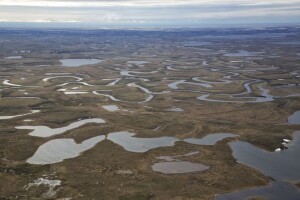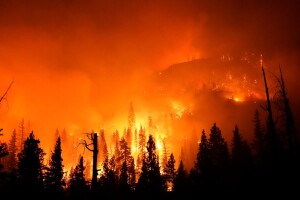For most of 2020, science reporting has been overwhelmingly focused on SARS-CoV-2, the coronavirus behind the Covid-19 pandemic that has infected millions and killed hundreds of thousands in our country alone – and is nowhere near under control. However, the massive wildfires now raging throughout the West Coast, especially in California where millions of acres have burned with the traditional fire season just underway, are a dramatic reminder that climate change is still very much a concern. And still nowhere near under control.
Washington Governor Jay Inslee calls the West Coast infernos “climate fires” rather than wildfires because their unparalleled magnitude and intensity are largely the result of dramatic climate changes brought on by human activity, mainly the burning of fossil fuels. He’s right. Most of California’s fires were started when nearly 12,000 lightning strikes bombarded the northern part of the state, which was sweltering under record-breaking triple digit temperatures. This unprecedented lightning barrage was accompanied by maybe 12 drops of rain, the first moisture to “wet” the region since January. The combination of heat and drought made for extremely parched vegetation, which in turn created a vast tinderbox primed for ignition.
There is a well-established link between these historic climate fires and sustained periods of excessively hot, dry air that have gravely impacted regional ecosystems. Earth’s average air temperature increased 2 degrees Fahrenheit during the 20th century and reputable models point to a further increase that could reach 10 degrees before the end of this century if current greenhouse gas emissions are not abated. Scientific consensus is that an increase between 3 and 4 degrees F is the threshold beyond which our planet and the biospheres that sustain us will suffer permanent damage.
Don’t let political hacks or fossil fuel flacks fool you, greenhouse gas emissions are the primary drivers behind climate change (See this). Unless we literally want to set the world on fire, drown our coastal cities under rising sea levels, and dislocate hundreds of millions of people, immediate steps must be taken to curb these emissions. At this critical juncture in human history, what does the Trump administration do? It releases the Kraken of climate change.
Methane is a carbon hydride greenhouse gas that doesn’t receive the publicity of carbon dioxide because of its much smaller presence in the atmosphere, as in 200 times scarcer. But what it lacks in presence, methane makes up for in potency. Over a 20-year period, methane will absorb 86 times more heat than the same amount of carbon dioxide. It has been estimated that as much as 25-percent of the atmospheric warming recorded over the past 100 years is due to methane, which is also a prodigious contributor to smog.
Certain politicians love to crack jokes about methane and cow farts. It’s true that cattle flatulence and agricultural waste send a significant amount of methane into the atmosphere, as do wetlands, rivers and lakes. However, only so much can be done to reduce these emissions – the argument that we simply eliminate beef from our diet is far from simple and deserves a blog of its own to explain the nuances. On the other hand, much can and has been done to reduce the equally significant amount of methane released into the atmosphere by the production of natural gas and petroleum, especially through fracking. In 2016, the Obama administration, under the Clean Air Act, enacted rules to reduce these methane emissions; rules supported by all the major oil companies because even their leadership realized that profits are useless on a dead planet.
In August of this year, EPA Administrator Andrew Wheeler, despite the opposition of the major oil companies, announced a rollback of the Obama administration rules, replacing them with new rules that ignore climate considerations and make future restrictions difficult if not impossible to implement.

Abrupt thawing of permafrost releases carbon in the form of methane, the Kraken of greenhouse gases (photo from Bureau of Land Management)
Setting aside the highly questionable politics, economics and ethics behind the rollback – this is a science blog after all – independent studies indicate the new methane emission rules will have the same impact on climate change as adding 100 coal-fired power plants every year. This could trigger a phenomenon known as “abrupt thaw” in Earth’s permafrost – the roughly seven million square miles of soil that are pretty much frozen year-round. Consisting of dirt, gravel and sand bound together by ice, permafrost is rich with the decomposed organics of plants and animals accumulated over tens of thousands of years. In other words it is a massive repository for carbon. How massive? It is estimated that Earth’s permafrost harbors some 1.5 trillion metric tons of carbon, which is double the amount of carbon in the entire atmosphere.
Some thawing of the permafrost during the summer season is a natural occurrence. During this gradual thawing, carbon is released as carbon dioxide; undesirable but adaptable. Under an abrupt thaw, however, in which pockets of permafrost melt all at once, the carbon is released as methane; potentially catastrophic. The same hot dry air that fuels apocalyptic climate fires also causes abrupt thawing of permafrost. Curbing the methane emitted as a result of human activity to the greatest extent we can is critical to slowing atmospheric warming, which in turn is critical to preventing large-scale abrupt thawing of the permafrost. The potential consequences of abrupt thawing of the permafrost are so dire as to make us all wish it had been the Kraken rather than methane that was released.

